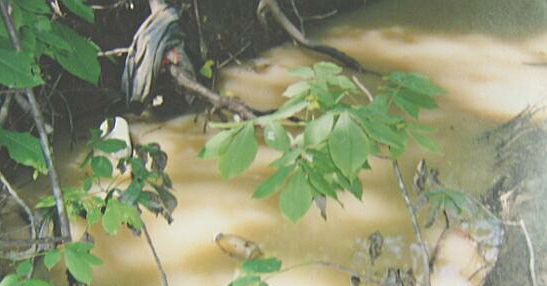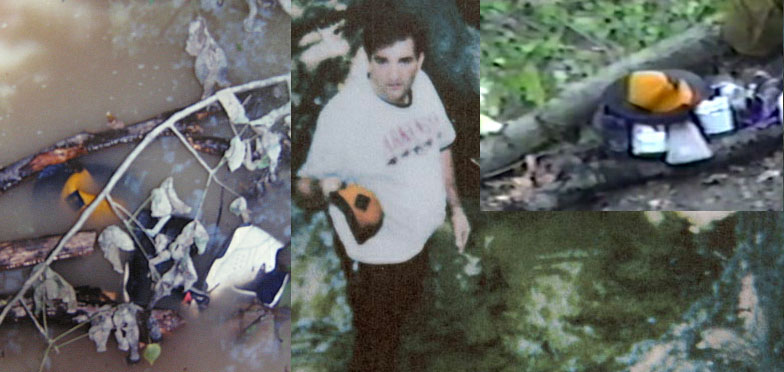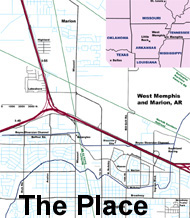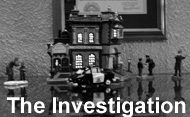Jivepuppi.com


"Boy pants" (Police description
from back of photo).
A Twilight Kill, Part Three:
Detective Bryn Ridge
It all went wrong with the discovery of the cub scout cap. Police
Lieutenant Bryn Ridge, then in his early thirties had wide expressive
eyes, thick arching brows, and a low-slung belly. He was called in to
explore the ditch, to retrieve the victims and their clothes. In a case
where very little physical evidence was to be found, the cub scout cap
had a hair and a fiber that didn't belong to the victims or their
clothing. It was vital
to ensure that contaminants didn't come from an outside source and a
long series of 68 questions at the trial addressed this matter. Ridge
was unequivocal: each of the items of clothing were immediately set
inside of paper sacks. And yet there, in a sequence of photographs,
the cap floating in the water, Ridge is holding the cap in his bare
hand and the cap is sitting atop a bundle of clothes on the bank.
Defense
attorney Paul Ford: Was the cap dripping when you pulled it out
of the water?
Ridge:
Yes sir.
Ford:
And you placed it directly into the sack?
Ridge:
Yes sir, I did.
Ford:
Was someone holding these sacks for you or - how did that procedure
take place?
Ridge:
Yes, Sergeant Allen was there
with me - holding the sacks as they were being placed in. [Ridge
testimony, Echols/Baldwin trial]

Cub scout cap in the water, being recovered by Det. Ridge, set on the
river bank with other clothes - and not in a sack.
Defense attorney Robin Wadley picked up
something
was wrong, but did not use the photos to contradict Ridge. Instead, he
focused on why, if wet clothes were placed inside of the paper sacks,
the sacks had no water markings.
Robin Wadley: You took the
clothes out - you described how you put the clothes, dripping wet, in
the sacks - is that correct?
Ridge: Yes sir.
Wadley: Now we've gone through
and we've looked at all these sacks today - did you have a chance to
look at all of these, Detective, as we were going through them?
Ridge: Yes sir, I did.
Wadley: And on any of the sacks
that you looked at, did you see any water marks on any of these sacks?
Ridge: I don't visibly see any,
no sir. [snip]
Wadley: How do you explain
that, Detective?
Ridge: I can't explain it.
[ibid]
Ridge, who would play a central role in the
investigation, was also a true believer. When asked why he believed the
murders were cult-related he ticked off a long list of reasons
including, "The bodies were in the nude, the Satanic term for that
would be "skyclad." Stab wounds, patterns, may have been done for the
purpose of bloodletting." [Ridge in camera testimony, Echols/Baldwin
trial]. A large portion of the police investigation
involved interviewing children about the rumored cult. One recorded
interview was with 13-year-old Tiffany Allen.
Ridge: Do you know of a satanic
group that exists [at] Lakeshore?
Allen: No sir
Ridge: You don't know of one at all?
Allen: No sir [Tiffany Allen, interview October 7, 1993]
Unsatisfied with this, Ridge went on to ask her
about rumors of its existence.
Ridge: Now the talk is that one
does exist and there are things that happen
Allen: Yes sir [ibid]
As was often the case, Ridge's summary of his
interviews reflected his thoughts rather than what appeared in the
recordings. "Tiffany admitted that she was aware that a cult like group
did exist..." and "She seemed afraid for her safety and reluctant to
give any information concerning these activities..." [Ridge,
summary notes, Tiffany Allen interview.]
During the trials, Ridge recounted interviewing one
member of the alleged cult, Ricky Climer. The text of the interview was
not presented at trial - perhaps because of its absurdity, including
Climer's claim that during the meetings they were attacked by
Smurfs.
Climer: Yeah, Smurfs, things
like that and the next thing you know, you
be, all of a sudden somebody will be running at you, and the Smurf has
a heart on his arms and he will be running at you and stuff, you
know. [Ricky Climer interview, June 16, 1993]
Ridge summarized Climer's interview. "Rickey is a 16
year old white male who seemed to be in good physical condition and to
me appeared to be quite street wise and able to carry on a conversation
with me that appeared to be normal for his age group." [Det. Ridge,
Climer interview summary]
Detective Ridge took the stand repeatedly during the
trials. In one visit the sum of his testimony was devoted to the color
of the t-shirts of the accused.
Prosecutor Fogleman: What color
are these shirts by the way?
Ridge: Black, with different designs and colors.
[cut - four more black t-shirts were presented]
Fogleman: And what color were these shirts again?
Ridge: Black. [Ridge testimony, Echols/Baldwin trial]
Black t-shirts were deemed to be evidence of
interest in the occult and became a symbol of a trials.
Continued in, A Twilight
Kill, Part Four: The Compromised.












